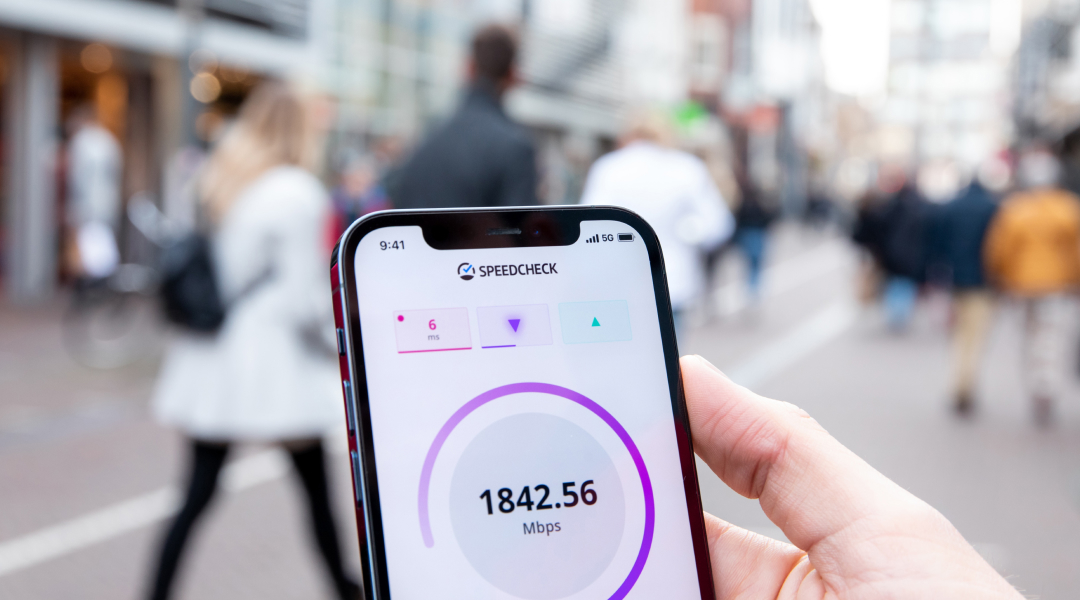5G, the fifth generation of mobile networks, marks a decisive step in the evolution of connectivity. Promising unprecedented speed, it is transforming digital usage and paving the way for innovations in all sectors. This article analyzes the promises, limitations, and future of this revolutionary technology: 5G speed.

What is 5G speed?
Definition of 5G a revolution for mobile broadband
5G refers to the latest generation of mobile networks, succeeding 44 G. Designed to offer an unparalleled user experience, it rests on three main pillars: increased speed, minimal latency, and enhanced connectivity. With a theoretical throughput of up to 10 Gbps, 5G is more than just a technological leap; it’s a revolution.
Unlike 4G, which focused primarily on streaming and downloads, 5G opens up an unprecedented range of applications. From virtual reality to remote-assisted surgery, the possibilities are immense.
How does 5G work?
5G uses higher frequencies than previous generations, including millimeter wave bands. These waves allow for faster data speeds and reduced latency, but they have a more limited range, requiring more antennas to cover a given area.
In parallel, 5G relies on “network slicing,” a technology that divides the network into slices dedicated to specific uses. For example, one slice can be reserved for autonomous vehicles, while another is used for high-definition streaming applications.
What are the advantages of 5G speed?
Unmatched download speed
With speeds far exceeding those of 4G, 5G allows you to download a 4K movie in seconds. This speed is transforming not only everyday use, but also sectors like education and entertainment.
Ultra-low latency for instant connections
Latency, or network response time, is one of the major advantages of 5G. With a theoretical latency of less than one millisecond, connections are almost instantaneous. This is essential for critical applications such as robotic surgery or competitive online gaming.
Exceptional density for connecting more devices
5G can handle up to one million connections per square kilometer, compared to 100,000 for 4G. This makes it possible to connect a multitude of objects in densely populated urban environments, from IoT sensors to connected vehicles.
The limits of 5G speed
Coverage still incomplete
Despite its potential, 5G is not yet available everywhere. Deploying the infrastructure requires time and significant investment, particularly in rural areas.
High infrastructure costs
The rollout of 5G involves enormous costs, both for operators and governments. These investments could lead to higher prices for consumers.
Potential cybersecurity risks
With an increased density of connected devices, 5G poses new security challenges. Connected objects, often vulnerable, become potential targets for cyberattacks.
What are the practical uses of 5G?
Improving smart cities
Smart cities will greatly benefit from 5G thanks to real-time optimized energy, transport, and security management systems.
Revolution in industry and logistics
In industry, 5G enables the monitoring and automation of complex processes in real time. In logistics, it facilitates supply chain management through connected sensors.
5G in healthcare teleconsultation and remote monitoring
5G is revolutionizing the medical sector by making telesurgery and remote patient monitoring possible, with unprecedented precision and speed.
Immersive applications virtual and augmented reality
Immersive experiences, such as virtual and augmented reality, are becoming more seamless and accessible thanks to 5G, opening up opportunities in entertainment, education, and commerce.
Comparison of 4G, 5G, and fiber which speed should you choose?
Key differences between 4G and 5G
5G surpasses 4G in terms of speed, latency, and connectivity. However, 4G remains relevant in areas where 5G coverage is unavailable.
Fiber vs 5G A technological duel?
Fiber offers a stable and fast connection at home, while 5G excels in mobile use. The choice therefore depends on your needs: whether you’re a home user or frequently on the go.
Which network is best suited to your needs?
For intensive use on the go, 5G is ideal. Fiber remains essential for households and businesses requiring a stable connection.
What is the current state of 5G coverage in France?
The major stages of deployment
5G coverage is expanding gradually, with priority given to major cities before deployment in rural areas.
Speed test Is 5G available in your area?
Online tools allow you to check if 5G is available near you. Operators regularly update their coverage maps.
The future of 5G speed
5G is just one step towards even more advanced connectivity. Eventually, it could incorporate technologies like 6G, offering even more impressive performance. It will also play a key role in the development of artificial intelligence and connected devices.
Conclusion
5G is redefining connectivity standards, offering unparalleled speed and versatility. While it presents challenges, its impact on society, the economy, and technology is undeniable. As its rollout continues, 5G is establishing itself as a cornerstone of digital innovation.
